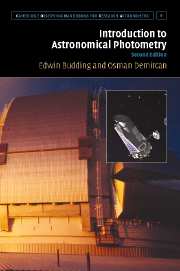Book contents
- Frontmatter
- Contents
- Preface to first edition
- Preface to second edition
- 1 Overview
- 2 Introduction
- 3 Underlying essentials
- 4 Themes of astronomical photometry
- 5 Practicalities
- 6 Procedures
- 7 Basic light curve analysis
- 8 Period changes in variable stars
- 9 Close binary systems
- 10 Spotted stars
- 11 Pulsating stars
- Appendix
- Author index
- Subject index
9 - Close binary systems
Published online by Cambridge University Press: 13 August 2009
- Frontmatter
- Contents
- Preface to first edition
- Preface to second edition
- 1 Overview
- 2 Introduction
- 3 Underlying essentials
- 4 Themes of astronomical photometry
- 5 Practicalities
- 6 Procedures
- 7 Basic light curve analysis
- 8 Period changes in variable stars
- 9 Close binary systems
- 10 Spotted stars
- 11 Pulsating stars
- Appendix
- Author index
- Subject index
Summary
In this chapter we proceed to more general effects in close binary light curves, with a wider sample of data sets. Although through most of the twentieth century close pairs formed a distinct subset of double star research, engendering its own data, purposes, methods and outcomes, in present times this somewhat artificial separation, mentioned at the beginning of the book, is being bridged. The time is in sight when photometric data can be more easily joined with astrometry for fuller analysis and information retrieval from close binary stars. To proceed with this, we need first to consider the overall geometry.
Coordinate transformation
Ambiguities are possible in bringing data on close binary systems into the conventional framework used for double stars, since, for example, the ‘longitude of periastron’ used for the radial velocities of spectroscopic binaries is normally measured inward from the plane of the sky and not the line of nodes in the equator, as in the standard 3-dimensional specification for astrometric binaries. If, as is usual for close systems, we use the local plane of the sky as the reference, the nodal angle Ω should still refer the line of intersection of orbital and sky planes to the equatorial coordinate system. This angle has no effect on radial velocities or photometric effects, though it remains a basic parameter of a binary system.
Information
- Type
- Chapter
- Information
- Introduction to Astronomical Photometry , pp. 310 - 340Publisher: Cambridge University PressPrint publication year: 2007
